Chapter 1: Android Activities
In This Chapter
![]() Launching an activity
Launching an activity
![]() Going through an activity’s lifecycle
Going through an activity’s lifecycle
![]() Getting information from an activity
Getting information from an activity
On a desktop computer, everything starts with a window. Open a window, and run a word processor. Open another window, and read your e-mail. Move a window, minimize a window, resize a window. It’s a very familiar story.
But mobile devices aren’t desktop computers. A smartphone has a relatively small screen, and if by chance you could open several windows at once, the phone’s processor would fall over from exhaustion. On a mobile phone, the “window” metaphor would lead to nothing but trouble.
Tablet devices have larger screens and better processors than their telephone cousins. You can probably squeeze a few windows on a tablet screen, but the power that you would allocate to window-handling could be put to better use.
So where does that leave you? The earliest computers had no windows and no multi-tasking. You can’t have that. Without some kind of multi-tasking, “smartphones” wouldn’t be smart.
Along comes Android’s solution — namely, the activity. In other chapters, I refer to an activity as “one ‘screenful’ of components.” I liken activities to online forms, such as “a form for entering information to make a purchase on a website.” I write, “Unlike most online forms, Android activities don’t necessarily have text boxes — places for the user to type credit card numbers and such. But Android activities have a lot in common with online forms.” I love quoting myself.
All about Activities
Here’s what the official Android docs say about an activity:
“An activity is a single, focused thing that the user can do. Almost all activities interact with the user, so the Activity class takes care of creating a window for you in which you can place your UI with setContentView(View). . . . Activities are often presented to the user as full-screen windows . . .”
The android.app.Activity class’s code is a complete, official definition describing what an activity is and what an activity isn’t. But from an app designer’s point of view, no formal definition of activity paints the complete picture. So maybe the way to describe an activity is behaviorally. Here’s my informal description:
At some point during the run of an app, an app designer fills up the screen with stuff. At that point, the designer thinks, “I have to move all this stuff out of the way so the user can deal sensibly with whatever has become most important.” So the designer creates a new screen layout, codes the layout’s behavior, and refers to the whole business (the layout and its behavior) as a new activity.
At that (newer) point, the designer has two different activities — the original activity that filled up the screen with stuff and the new activity that deals with whatever has become most important. On a smaller device (or on a device running anything earlier than Honeycomb), each activity fills the entire screen. The original activity invokes the new activity and then the new activity covers the original activity.
Under normal circumstances, the two activities form part of a stack — a first in, last out structure. Imagine that Activity A invokes Activity B, which in turn invokes Activity C. Then the activities A, B, and C form a stack, with Activity C being on top of the stack (and visible to the user). When the user presses the Back button, Activity C pops off the stack to reveal Activity B. When the user presses the Back button again, Activity B pops off the stack to reveal Activity A.
A stack of Android activities is called a task. So now you have apps, activities, and tasks. Unfortunately, these words have different meanings for Android developers than they have for the rest of the world.
An application is a collection of things meant to accomplish a particular user goal. Some of the things belonging to an app are activities.
Each application runs in its own Android Linux process, with its own user ID. This is one of Android’s security strengths. Separate processes don’t share any memory. So in effect, each application is sandboxed from the rest of the system, with very narrowly defined (tightly guarded) paths of communication between one application and another. If an application does something wrong (either maliciously or unintentionally), the chance of that wrongdoing affecting the rest of the system is limited. As a developer, you create an application using the XML <application> element in the app’s AndroidManifest.xml file.
An activity can (and frequently does) invoke activities belonging to other apps. (For example, an e-mail message might contain a link. So an e-mail app’s activity might invoke a web browser app’s activity.) That means that a particular task might contain activities from several applications. (See Figure 1-1.)
Figure 1-1: Activities, apps, and tasks.

The scenario often works this way:
1. The user starts an app. (Call it Application 1.)
Android creates a new process for the app, creates an instance of the app’s main activity, and puts the main activity onto a brand-new task stack. (Call it Task 1.)
2. From the app’s main activity, the user invokes another activity (say, a secondary activity belonging to the same app).
Android creates a new instance of the secondary activity. Android pushes the secondary activity onto the task stack. (See Figure 1-2.) The device’s screen displays only the secondary activity. (Think of the app’s main activity as being hidden underneath the secondary activity. Call the main activity Activity 1; call the secondary activity Activity 2.)
Figure 1-2: The user launches Activities 1 and 2.

3. The user presses Home.
Android moves Task 1 off the screen and displays the Home screen, as shown in Figure 1-3.
4. The user starts a second app. (How about calling it Application 2?)
With the Task 1 still waiting in the wings, Android creates a second task (Task 2) with the second app’s main activity.
5. The user presses Home again and presses the icon for Application 1.
See Figure 1-4. Android displays the top of the Task 1 stack. Activity 2 is still at the top of Task 1. So the user sees Activity 2. Happily, Activity 2 is in the same state as it was when the user first pressed Home. Any text fields still have whatever text the user previously entered, and so on.
6. The user presses the Back button.
Android pops Activity 2 off the Task 1 stack and destroys this instance of Activity 2. The user sees Activity 1, which is in the same state as it was immediately before Android covered up Activity 1 with Activity 2.
7. From Activity 1, the user again invokes the secondary activity belonging to Application 1.
Android creates a brand-new instance of the secondary activity. Android pushes the secondary activity onto the task stack. The device’s screen displays only the secondary activity. This new instance is not in the same state that Activity 2 was in when Activity 2 was destroyed. This new instance is initialized with new values (which is normal for brand-new objects).
Figure 1-3: After invoking Application 2, the user returns home.
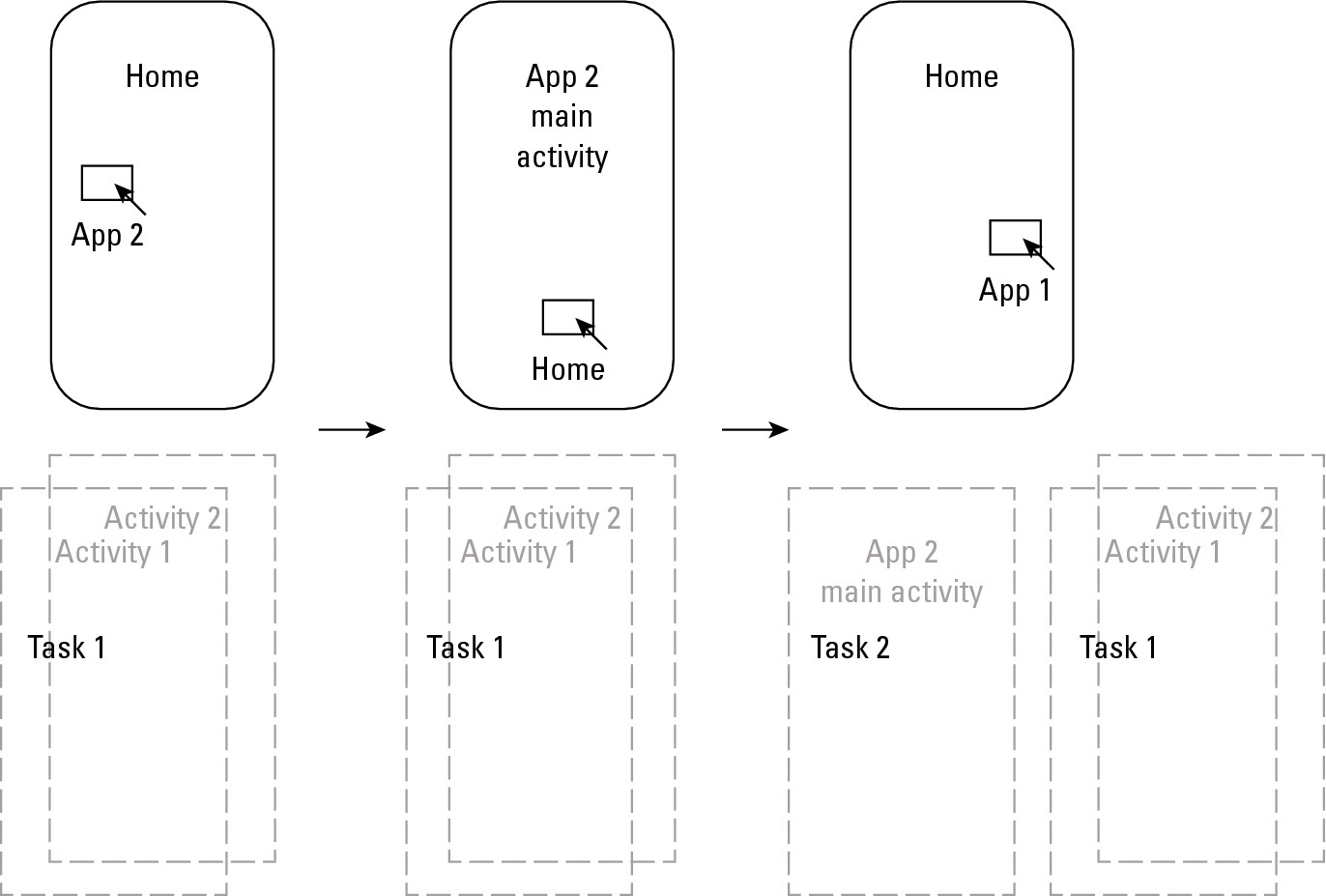
Figure 1-4: The user dismisses Activity 2 and then invokes Activity 2.
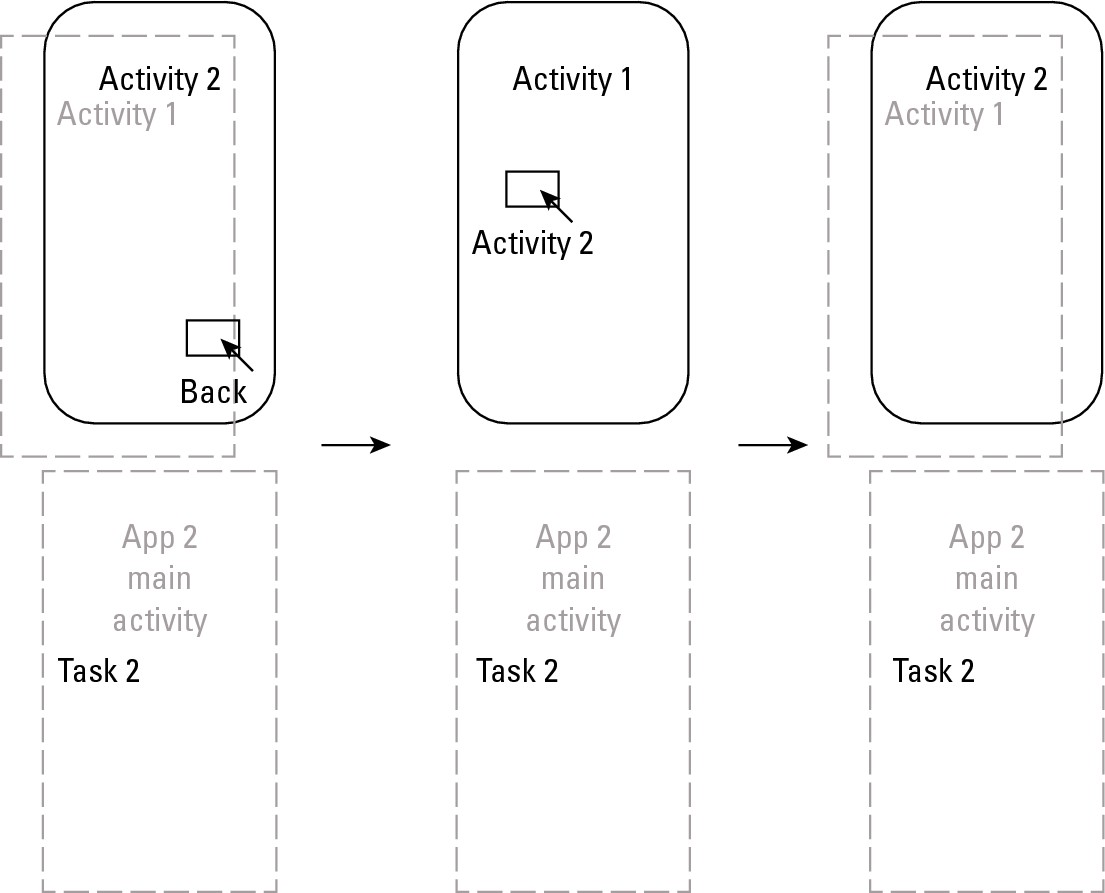
State your intention
The Android programming model is based on the use of scarce resources. Compared to a desktop or laptop computer, a smartphone has a small screen, limited memory, and a wimpy processor. With that in mind, the original creators of Android focused on reuse.
Imagine that my app includes a link to my website. When the user clicks the link, Android opens a web browser. But which browser does Android open? Android comes with its own browser (based on Apple’s WebKit engine). But the user might have also installed Firefox for Android, Opera Mini, or any number of other web browsers.
In Microsoft Windows, the choice of browser depends on filename extensions and protocol associations. But in Android, the developer invokes a browser by issuing an intent.
In Android development, an intent is like an open-ended method call. Instead of coding something like
firefox(“http://www.google.com”);
or
android_built_in_browser(“http://android.allmycode.com”);
you code the following:
String url = “http://android.allmycode.com”;
Intent intent = new Intent(Intent.ACTION_VIEW);
intent.setData(Uri.parse(url));
startActivity(intent);
In this example, calling startActivity(intent) is like throwing an I-want-to-browse ball into the air and expecting another app’s activity to catch it. Another app announces its intentions to catch the I-want-to-browse ball by putting an element of the following kind in the app’s AndroidManifest.xml file:
<activity android:name=”.Catcher”
android:label=”Catcher”>
<intent-filter>
<action
android:name=”android.intent.action.VIEW” />
<category
android:name=”android.intent.category.DEFAULT” />
<category
android:name=”android.intent.category.BROWSABLE” />
<data android:scheme=”http” />
</intent-filter>
</activity>
Again, I quote Android’s official documentation:
“An intent is an abstract description of an operation to be performed. It can be used with startActivity to launch an Activity, ... . An Intent provides a facility for performing late runtime binding between the code in different applications. Its most significant use is in the launching of activities, where it can be thought of as the glue between activities. It is basically a passive data structure holding an abstract description of an action to be performed.”
In truth, Android has two kinds of intents — implicit and explicit intents.
• The kind of intent that I describe in the previous paragraphs (to start any activity claiming to be a web browser) is an implicit intent. An implicit intent doesn’t call for a particular activity to be launched. Instead, an implicit intent names an action to be taken, along with other information required to fulfill the intent.
The intent
Intent intent = new Intent(Intent.ACTION_VIEW);
intent.setData(Uri.parse(url));
is an implicit intent.
 I cover implicit intents in Chapter 2 of this minibook.
I cover implicit intents in Chapter 2 of this minibook.
• An explicit intent actually names an activity class whose instance is to be launched.
In this chapter’s examples, I use explicit intents to launch activities. So the next section covers explicit intents.
The explicit intent
To use an explicit intent, you can write something like code in Listing 1-1.
Listing 1-1: Calling Your Own App’s Activity Using an Explicit Intent
package my.pack;
import android.app.Activity;
import android.os.Bundle;
public class SomeActivity extends Activity {
// ... code of some sort belongs here
Intent intent = new Intent();
intent.setClassName(“my.pack”, “my.pack.OtherActivity”);
startActivity(intent);
}
In Listing 1-1, the intent’s setClassName method takes two String parameters. The first parameter is the name of the package containing the target activity, and the second parameter is the activity’s fully qualified class name. So in Listing 1-1, the call to setClassName has two strings containing “my.pack”. (There may be a reasonable way to avoid repetition, where you’d write something like setClassName(“my.pack”, “OtherActivity”). But if there is one, no one’s told me about it.)
To invoke another app’s activity, you can write something like the code in Listing 1-2.
Listing 1-2: Calling another App’s Activity Using an Explicit Intent
package my.pack;
import android.app.Activity;
import android.os.Bundle;
public class SomeActivity extends Activity {
// ... code of some sort belongs here
intent = new Intent();
intent.setClassName(“other.pack”,
“other.pack.OtherAppActivity”);
startActivity(intent);
}
Listing 1-2 is almost exactly like Listing 1-1. The only difference is that in Listing 1-2, the two activities (the invoking and the invoked activities) belong to two different applications. Different applications means different packages. So Listing 1-1 has “my.pack”, and Listing 1-2 has “other.pack”.
Using a context
Another way to start a specific activity is with a context. In Listing 1-3, an activity calls another activity within the same application.
Listing 1-3: Calling Your Own App’s Activity Using an Explicit Intent with a Context
package my.pack;
import android.app.Activity;
import android.os.Bundle;
public class SomeActivity extends Activity {
// ... code of some sort belongs here
Intent intent =
new Intent(this, OtherActivity.class);
startActivity(intent);
}
In Listing 1-3, the last two statements are really saying, “With this activity’s own context, start running an instance of OtherActivity.” (If all goes well, the class OtherActivity extends Android’s Activity class, and you’re good to go.)
In Listing 1-3, the Intent class’s constructor takes two parameters — a context and a Java class. The word this represents the enclosing SomeActivity instance. That’s good, because the constructor’s first parameter is of type Context, and Android’s Activity class is a subclass of the abstract Context class.
A Context object is an “interface to global information about an application environment.” (Again, I’m quoting the Android docs.) An activity is a context because (aside from being a subclass of Context) an activity has a bunch of files, a package name, a bunch of resources, a theme, wallpaper, and other things. All this stuff is available programmatically by way of the activity’s context. In Listing 1-3, the Intent constructor gets the OtherActivity’s package name from this — the SomeActivity object’s context.
Each activity is part of an application, and an Application instance is also a context. So in many programs, you can use any of the following method calls (instead of this) to obtain a Context instance:
getContext()
getApplicationContext()
getBaseContext()
In Listing 1-4, an activity from one app uses a context to call another app’s activity.
Listing 1-4: Calling another App’s Activity Using an Explicit Intent with a Context
package my.pack;
import android.app.Activity;
import android.os.Bundle;
public class SomeActivity extends Activity {
// ... code of some sort belongs here
try {
otherContext =
createPackageContext(“other.pack”,
Context.CONTEXT_IGNORE_SECURITY |
Context.CONTEXT_INCLUDE_CODE);
} catch (NameNotFoundException e) {
e.printStackTrace();
}
Class<?> otherClass = null;
try {
otherClass = otherContext.getClassLoader().
loadClass(“other.pack.OtherAppActivity”);
} catch (ClassNotFoundException e) {
e.printStackTrace();
}
Intent intent = new Intent(otherContext, otherClass);
startActivity(intent);
}
Listing 1-4 is more complicated than Listing 1-3. But most of the complexity comes from the way Java loads classes. One way or another, Listing 1-4 creates an intent from a context and a class name, and then starts the intent’s activity.
The Activity Lifecycle
“... And one man in his time plays many parts, His acts being seven ages.”
— from As You Like It, by William Shakespeare
The human lifecycle is infancy, childhood, adolescence, young adulthood, middle age, old age, and finally, the end.
Android activities have a lifecycle, too. Here are the stages:
• Active (or Running): The activity is in the foreground on the device’s screen at the top of a task stack. The user can interact with the activity.
• Stopped: The activity is on a task stack, but the activity isn’t visible. Maybe the activity isn’t at the top of its stack and other activities on the stack are covering up that activity. Alternatively, the activity isn’t visible because the device’s screen displays something that’s not part of this activity’s stack.
• Paused: The Paused state is a kind of limbo between Active and Stopped. Officially, an activity is paused if it’s on the currently active stack but it’s partially obscured by another activity (such as a transparent activity or a non-full-screen activity that’s at the top of the stack).
In practice, an activity that’s transitioning from Active to Stopped goes through a brief period of being Paused, even if the user doesn’t see a “partially obscured” phase.
• Destroyed: How sad! But wait! Destroyed doesn’t mean “dead and gone forever.” Android might destroy an activity in order to revive it with a different configuration. Or Android might temporarily clobber an activity while the user isn’t actively using that activity.
Lifecycle methods
Most cultures have rites of passage. A rite of passage is something that you do when you transition from one life stage to another. For example, where I come from, a child does the following when transitioning to adolescence: “Ye shall stand at the highest point in all of thy land (which is normally the Dauphin Street station of the Frankford El train) and swing a raw fish thrice over thy head. All the while, thou shalt exclaim, ‘I shall be a troublesome, raving lunatic for the next few years.’ “
Android activities have their own rites of passage, dubbed lifecycle methods. Figure 1-5 illustrates the methods.
Unlike people, activities don’t step predictably from one stage to the next. For example, a typical activity goes back and forth from being Active to Stopped and back to Active again, with several interludes of being Paused. And when Destroyed, an activity can unceremoniously be revived. For an activity, destruction and reconstruction are parts of the normal course of events.
An Android activity has seven lifecycle methods — namely, onCreate, onRestart, onStart, onResume, onPause, onStop, and onDestroy. In addition, an activity has a few onSomething methods (such as onSave InstanceState) that aren’t formally part of the lifecycle and aren’t guaranteed to be called. Anyway, Listing 1-5 contains a bunch of these methods.
Figure 1-5: The life, death, and rebirth of an Android activity.

Listing 1-5: Add Some Logging to Your Activity
package com.allmycode.demo1;
import android.app.Activity;
import android.content.res.Configuration;
import android.os.Bundle;
import android.view.View;
public abstract class MyActivity extends Activity {
abstract void logStuff(String message);
public void addBreak(View view) {
logStuff(“------”);
}
/** Called when the activity is created (either
* for the first time or after having been
* Destroyed. */
@Override
public void onCreate(Bundle savedInstanceState) {
super.onCreate(savedInstanceState);
logStuff(“onCreate”);
}
/** Called when the activity transitions to
* Paused (on its way to Active) after having
* been Stopped.
*/
@Override
public void onRestart() {
super.onRestart();
logStuff(“onRestart”);
}
/** Called when the activity transitions to
* Paused (on its way to Active), either for
* the first time or after the activity has
* been Stopped.
*/
@Override
public void onStart() {
super.onStart();
logStuff(“onStart”);
}
/** Called when the activity transitions
* from Paused to Active.
*/
@Override
public void onResume() {
super.onResume();
logStuff(“onResume”);
}
/** Never called unless you set
* android:configChanges in the
* AndroidManifest.xml file.
*/
@Override
public void onConfigurationChanged
(Configuration config) {
super.onConfigurationChanged(config);
logStuff(“onConfigurationChanged”);
}
/** Usually (but not always) called during the
* transition from Active to Paused, or during
* the transition from Paused to Stopped.
*/
@Override
public void onSaveInstanceState(Bundle state) {
super.onSaveInstanceState(state);
logStuff(“onSaveInstanceState”);
}
/** Called when the activity transitions from
* Active to Paused.
*/
@Override
public void onPause() {
super.onPause();
logStuff(“onPause”);
}
/** Called when the activity transitions from
* Paused to Stopped.
*/
@Override
public void onStop() {
super.onStop();
logStuff(“onStop”);
}
/** Called when the activity transitions from
* Stopped to Destroyed.
*/
@Override
public void onDestroy() {
super.onDestroy();
logStuff(“onDestroy”);
}
}
My goal in creating Listing 1-5 is to provide logging that helps you see the lifecycle methods in action. You can drop Listing 1-5 into almost any app to get a Burd’s-eye view of your activities and their transitions. To this end, I’ve created an app that lets you bounce back and forth among different kinds of activities. Listings 1-6, 1-7, and 1-8 describe the app’s main activity, and Figure 1-6 shows the main activity’s screen.
Listing 1-6: The com.allmycode.demo1.Demo1Activity Class
package com.allmycode.demo1;
import android.content.Intent;
import android.os.Bundle;
import android.util.Log;
import android.view.View;
public class Demo1Activity extends MyActivity {
@Override
public void onCreate(Bundle savedInstanceState) {
super.onCreate(savedInstanceState);
setContentView(R.layout.main);
}
@Override
void logStuff(String message) {
Log.i(“Demo1Activity”, message);
}
public void startOtherActivity(View view) {
Intent intent = new Intent();
intent.setClassName(“com.allmycode.demo1”,
“com.allmycode.demo1.OtherActivity”);
startActivity(intent);
}
public void startOtherAppActivity(View view) {
Intent intent = new Intent();
intent.setClassName(“com.allmycode.demo1A”,
“com.allmycode.demo1A.OtherAppActivity”);
startActivity(intent);
}
public void startTransparentActivity(View view) {
Intent intent = new Intent();
intent.setClassName(“com.allmycode.demo1”,
“com.allmycode.demo1.TranslucentActivity”);
startActivity(intent);
}
}
Listing 1-7: The main.xml File
<?xml version=”1.0” encoding=”utf-8”?>
<LinearLayout xmlns:android=
“http://schemas.android.com/apk/res/android”
android:orientation=”vertical”
android:layout_width=”fill_parent”
android:layout_height=”fill_parent”>
<TextView android:layout_width=”fill_parent”
android:layout_height=”wrap_content”
android:text=”@string/hello” />
<Button android:layout_width=”wrap_content”
android:id=”@+id/button1”
android:onClick=”startOtherActivity”
android:layout_height=”wrap_content”
android:text=”@string/start_this_app_other”>
</Button>
<EditText android:layout_height=”wrap_content”
android:id=”@+id/editText1”
android:layout_width=”match_parent”
android:hint=”Type anything here”>
<requestFocus></requestFocus>
</EditText>
<include android:id=”@+id/include1”
android:layout_width=”wrap_content”
layout=”@layout/add_break”
android:layout_height=”wrap_content”>
</include>
<Button android:id=”@+id/button2”
android:layout_width=”wrap_content”
android:layout_height=”wrap_content”
android:onClick=”startOtherAppActivity”
android:text=”@string/start_other_app”>
</Button>
<Button android:id=”@+id/button3”
android:layout_width=”wrap_content”
android:layout_height=”wrap_content”
android:onClick=”startTransparentActivity”
android:text=”@string/start_translucent”>
</Button>
</LinearLayout>
Listing 1-8: The add_break.xml File
<?xml version=”1.0” encoding=”utf-8”?>
<LinearLayout xmlns:android=
“http://schemas.android.com/apk/res/android”
android:orientation=”vertical”
android:layout_width=”match_parent”
android:layout_height=”match_parent”
android:gravity=”center”>
<Button android:id=”@+id/button1”
android:layout_width=”wrap_content”
android:layout_height=”wrap_content”
android:onClick=”addBreak”
android:text=”@string/add_break”>
</Button>
</LinearLayout>
Figure 1-6: The main activity’s screen.
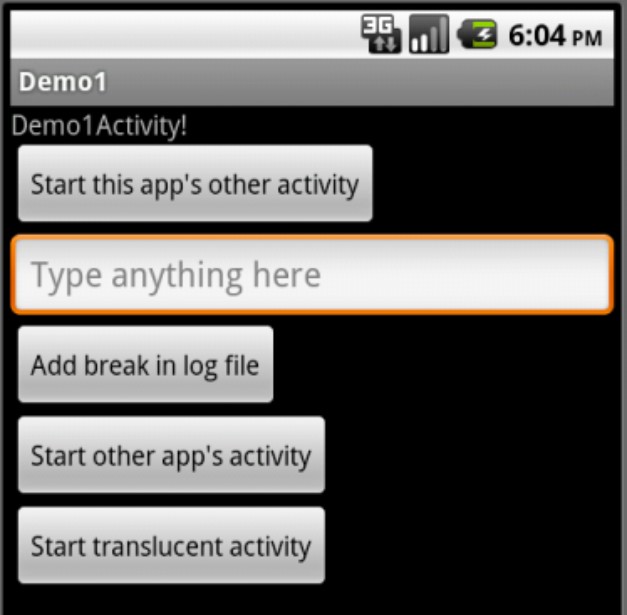
I cover most of the Android coding tricks in Listings 1-6, 1-7, and 1-8 in Book I, Chapters 3 and 4. But these listings form the basis for an app that lets you experiment with the activity lifecycle. The next section describes what the widgets in Figure 1-6 (and a few other buttons) do.
Taking an activity lifecycle through its paces
No two lives are the same, so it would make sense that there is an infinite variety as well to the lifecycles of individual activities. If you dutifully followed my advice about downloading the code from Listings 1-6, 1-7, 1-8, and 1-9 from this book’s website, you can follow along as I demonstrate the kinds of curveballs I can throw at an activity lifecycle.
Starting another activity in the same app
In Figure 1-6, you can click the Start This App’s Other Activity button to cover up the main activity with another activity from the same application. When you click the button, Eclipse’s LogCat view displays the following entries:
INFO/Demo1Activity(4526): onSaveInstanceState
INFO/Demo1Activity(4526): onPause
WARN/OtherActivity(4526): onCreate
WARN/OtherActivity(4526): onStart
WARN/OtherActivity(4526): onResume
INFO/Demo1Activity(4526): onStop
An OtherActivity instance goes from not existing to being Active, and the Demo1Activity instance goes from being Active to being Stopped.
Taking a break
In Figure 1-6, you can click the Add Break in Log File button to add an entry whose message is a dashed line. Press this button to help you keep track of the parts in a long log file.
The Back button
Your device’s Back button pops an activity off the task stack.
Imagine that with Demo1Activity and OtherActivity on the stack, you press the Back button. As a result, Eclipse’s LogCat view displays the following entries:
WARN/OtherActivity(4526): onPause
INFO/Demo1Activity(4526): onRestart
INFO/Demo1Activity(4526): onStart
INFO/Demo1Activity(4526): onResume
WARN/OtherActivity(4526): onStop
WARN/OtherActivity(4526): onDestroy
Notice that pressing the Back button destroys the OtherActivity instance.
Saving (and not saving) an activity’s state
In Figure 1-6, the Type Anything Here text field helps you understand when an activity’s state is preserved (and when it’s not).
Try this experiment:
1. Type something in the text field and then click the Start This App’s Other Activity button.
OtherActivity obscures Demo1Activity, and Demo1Activity is Stopped.
2. Dismiss OtherActivity with the Back button.
The Demo1Activity reappears with your typed characters still in the text field. In spite of Demo1Activity’s being stopped, Android has preserved the state of Demo1Activity.
Try another experiment:
1. Type something in the text field and then click the Home button.
The Home screen appears, and Demo1Activity is Stopped.
2. Find the Demo1 icon and touch the icon to invoke Demo1Activity.
The Demo1Activity reappears with your typed characters still in the text field. Android has preserved the state of the Demo1Activity.
Here’s another experiment:
1. Type something in the text field and then click the Back button.
The Demo1Activity’s screen goes away. In the LogCat view, you see Demo1Activity execute its onPause, onStop, and onDestroy methods.
2. Find the Demo1 icon and touch the icon to invoke Demo1Activity.
The Demo1Activity reappears, but the Type Anything Here text field has been re-initialized. Android hasn’t preserved the Demo1Activity’s state.
3. (Optional) To preserve a state between Back-button clicking and an activity’s next invocation, add the following code to your activity’s onPause method:
SharedPreferences prefs =
getPreferences(MODE_PRIVATE);
SharedPreferences.Editor editor = prefs.edit();
editor.putString(“EditTextString”,
editText.getText().toString());
editor.commit();
4. Add the following code to your activity’s onResume method:
SharedPreferences prefs =
getPreferences(MODE_PRIVATE);
String str = prefs.getString(“EditTextString”, “”);
editText.setText(str);
 5. Save an activity’s relevant information in your override of the
5. Save an activity’s relevant information in your override of the onPause method.
Don’t wait to save the information in the onStop or onDestroy method.
 The code in Step 4 uses
The code in Step 4 uses SharedPreferences. For more about SharedPreferences, see Chapter 3 in this minibook.
Here’s your next experiment:
1. Type something in the text field.
2. Turn your device sideways.
If you’re running an emulator, you can do a virtual turn by pressing Ctrl+F11. Your activity’s screen adjusts (from portrait to landscape or vice versa) and your typed characters are still in the text field.
But when you look at Eclipse’s LogCat view, you see the following entries:
INFO/Demo1Activity(4526): onSaveInstanceState
INFO/Demo1Activity(4526): onPause
INFO/Demo1Activity(4526): onStop
INFO/Demo1Activity(4526): onDestroy
INFO/Demo1Activity(4526): onCreate
INFO/Demo1Activity(4526): onStart
INFO/Demo1Activity(4526): onResume
Surprise! In order to rotate your activity’s screen, Android destroys and then re-creates the activity. And between destruction and subsequent creation, Android preserves your activity instance’s state. The text field’s content is restored.
This leads you to one more experiment:
1. Add the following attribute to the Demo1Activity’s <activity> element in the AndroidManifest.xml file:
android:configChanges=”orientation”
2. Turn the app and change the orientation of the emulator or the device.
You see the following entries in Eclipse’s LogCat view:
INFO/Demo1Activity(4588): onSaveInstanceState
INFO/Demo1Activity(4588): onPause
INFO/Demo1Activity(4588): onStop
INFO/Demo1Activity(4588): onDestroy
INFO/Demo1Activity(4588): onCreate
INFO/Demo1Activity(4588): onStart
INFO/Demo1Activity(4588): onResume
INFO/Demo1Activity(4588): onConfigurationChanged
The android:configChanges=”orientation” attribute tells Android to notify the activity about orientation changes. So Android calls the activity’s onConfigurationChanged method which, in Listing 1-5, logs the event. Under normal circumstances, you’d use the attribute to intercept the default actions when the user tilts the device so you could then handle the event with your own code.
Starting another app’s activity
In Figure 1-6, you can click the Start Other App’s Activity button to cover up the main activity — you essentially cover the main activity with an activity from a different application. When you click the button, Eclipse’s LogCat view displays the following entries:
INFO/Demo1Activity(4688): onSaveInstanceState
INFO/Demo1Activity(4688): onPause
VERBOSE/OtherAppActivity(4697): onCreate
VERBOSE/OtherAppActivity(4697): onStart
VERBOSE/OtherAppActivity(4697): onResume
INFO/Demo1Activity(4688): onStop
The only difference between these entries and the entries in previous examples is that these entries use two PID numbers. In this example, the Demo1Activity has PID 4688, and the OtherAppActivity has PID 4697. As promised, two different apps run in two different operating system processes, and each process has its own PID. You can get independent verification of this fact by examining Eclipse’s Devices view (in the DDMS perspective). Figure 1-7 shows you the Devices view.
Figure 1-7: The Devices view.
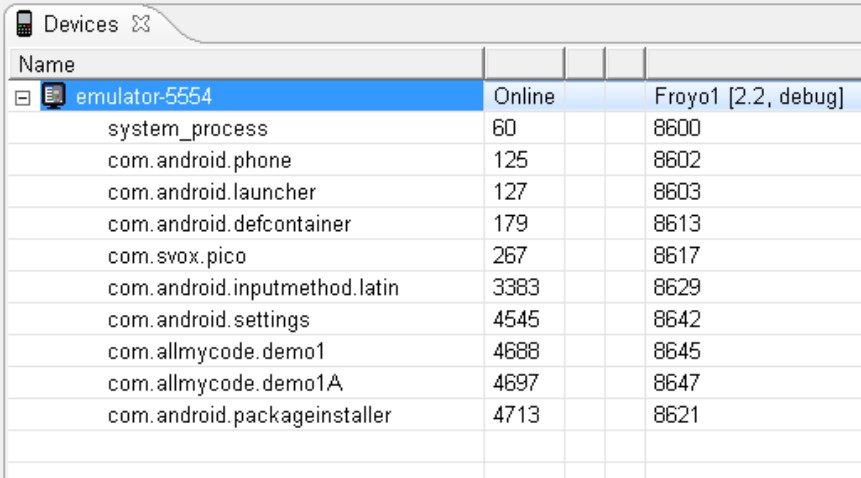
In Figure 1-7, the process running Demo1Activity (in package com.allmy code.demo1) has PID 4688. And the process running OtherAppActivity (in package com.allmycode.demo1A) has PID 4697.
Overloading the system
As the sun sets on the “Starting another app’s activity” section, you’re running two com.allmycode processes. (Refer to Figure 1-7.) On your emulator’s screen, the com.allmycode.demo1.Demo1Activity is obscured by the com.allmycode.demo1A.OtherAppActivity.
So you can conduct another experiment:
1. Get your emulator (or device) in the state described at the end of the “Starting another app’s activity” section.
To do so, start the app whose main activity is in Listing 1-6. Then click the Start Other App’s Activity button.
2. Press the emulator’s Home button.
See Figure 1-8. You’re not pressing the Back button, so you’re not backing out of the OtherAppActivity or the Demo1Activity. Those two activities are Stopped, not Destroyed. (You can verify this by looking at the Eclipse’s LogCat view.)
Figure 1-8: As the user browses, a task hides in the shadows.
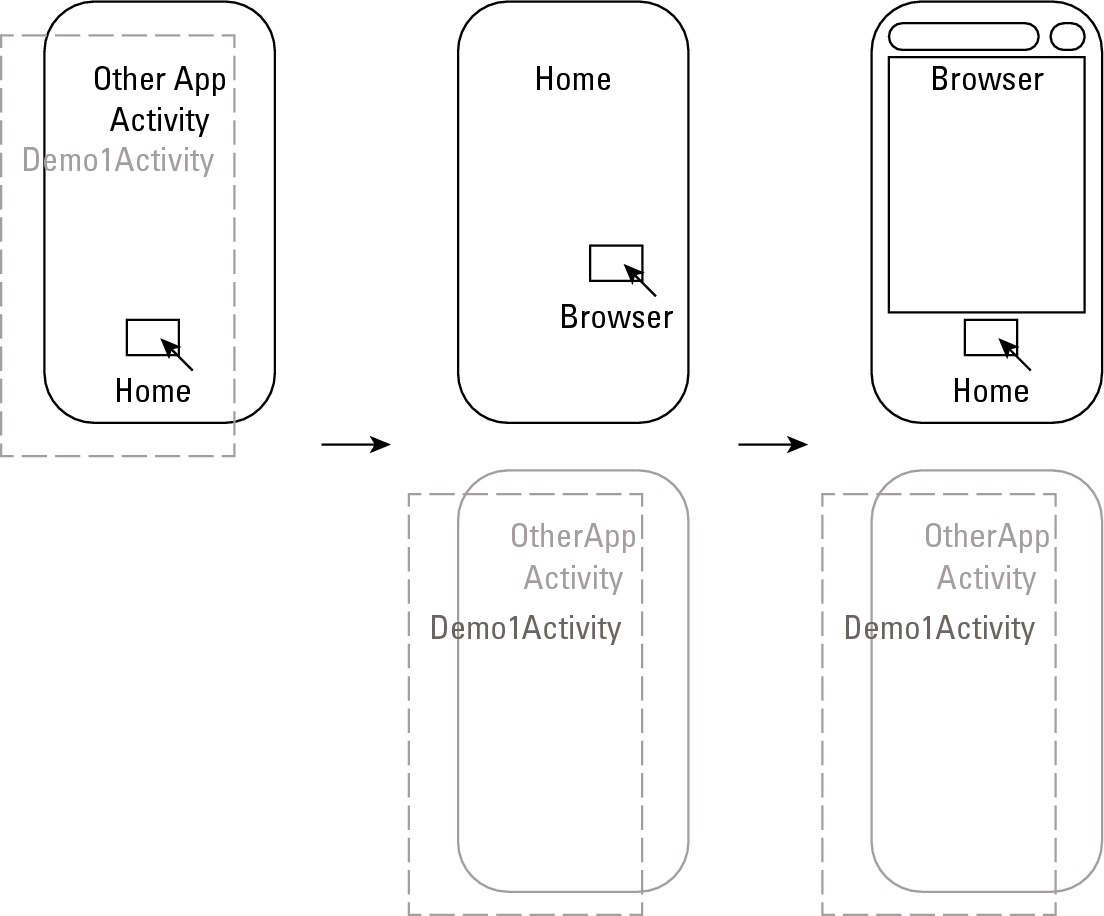
3. With your eye on Eclipse’s Devices and LogCat views, start several of the emulator’s built-in apps.
Start apps such as the browser, e-mail, contacts, and maybe more. In each case, keep the current activity alive by pressing Home instead of Back.
At some point, you see the com.allmycode.demo1 process disappear from Eclipse’s Devices view. (See Figure 1-9.) Android has reclaimed memory by killing off a process. After all, the com.allmycode.demo1.Demo1Activity instance is Stopped, so Android figures it can destroy that activity. The com.allmycode.demo1A.OtherAppActivity is also Stopped. But the last time you saw OtherAppActivity, that activity was at the top of a task stack.
Figure 1-9: The package com.allmycode.demo1 has disappeared.
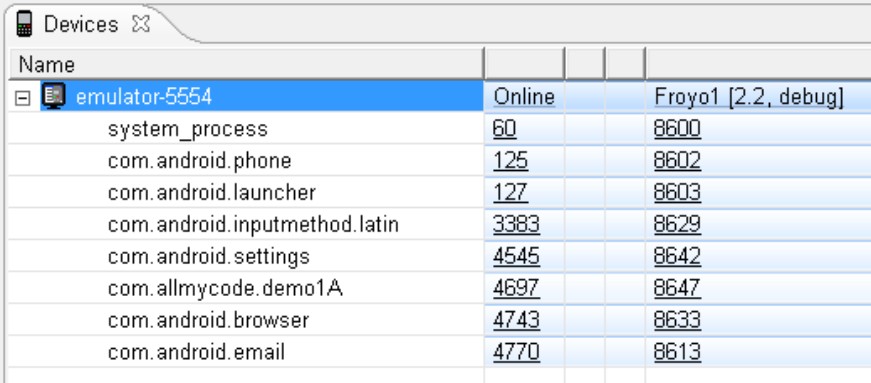
Android kills a process in order to reclaim space, and the user has no clue that the process has been killed. This is business as usual for the Android operating system.
At this point in the experiment, the Demo1Activity is Stopped, the activity’s process has been killed, and the activity isn’t on top of its current task.
4. Return to the emulator’s Apps screen and click the Demo1 icon (the icon for the com.allmycode.demo1.Demo1Activity instance).
The OtherAppActivity reappears on the screen. (See Figure 1-10.) Android interprets your click as a wish to return to the top of the task stack containing Demo1Activity, and not to Demo1Activity itself. In the LogCat view, OtherAppActivity has restarted, started, and resumed. In Eclipse’s Devices view, you still don’t see com.allmycode.demo1.
5. Press the emulator’s Back button.
Android remembers that com.allmycode.demo1.Demo1Activity was hidden (conceptually) underneath OtherAppActivity on the task stack. Because the com.allmycode.demo1 process no longer exists, Android creates a new process with a new PID to run the com.allmy code.demo1.Demo1Activity code.
As a result, Demo1Activity appears on your emulator’s screen, com.allmycode.demo1 reappears in Eclipse’s devices view with a new PID, and the following entries appear in Eclipse’s LogCat view:
Figure 1-10: Returning to a task.
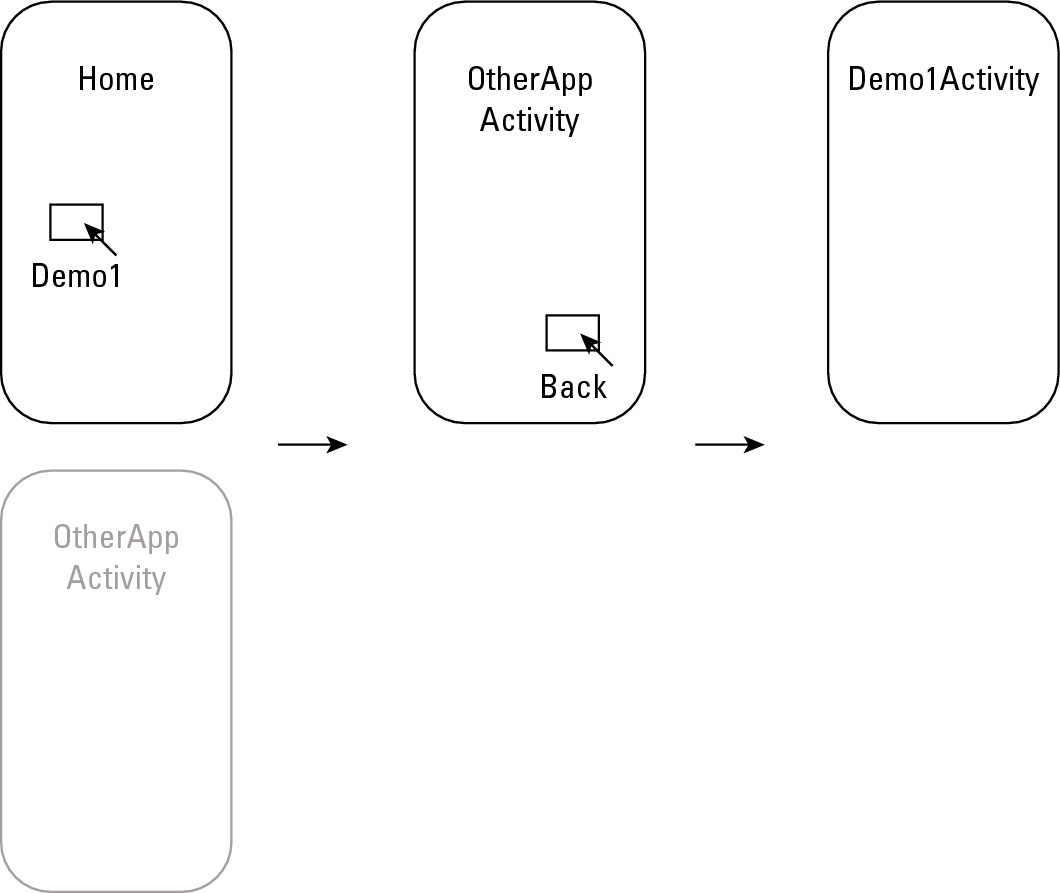
VERBOSE/OtherAppActivity(4697): onPause
INFO/Demo1Activity(4783): onCreate
INFO/Demo1Activity(4783): onStart
INFO/Demo1Activity(4783): onResume
VERBOSE/OtherAppActivity(4697): onStop
VERBOSE/OtherAppActivity(4697): onDestroy
Unbeknownst to the user, Android has restored the Demo1Activity in a new process.
Partially covering an activity
In Figure 1-6, clicking the Start Translucent Activity button does what you think it should do. The button makes Android invoke a see-through activity. (App development terminology tends to blur the difference between “translucent” and “transparent.” Get it? “Blur” the difference?) Of course, you can’t invoke a translucent activity unless you have a translucent activity to invoke. So Listing 1-9 shows you how to create a translucent activity.
Listing 1-9: The AndroidManifest.xml File for One of This Chapter’s Big Projects
<?xml version=”1.0” encoding=”utf-8”?>
<manifest xmlns:android=
“http://schemas.android.com/apk/res/android”
package=”com.allmycode.demo1”
android:versionCode=”1”
android:versionName=”1.0”>
<uses-sdk android:minSdkVersion=”8” />
<application android:icon=”@drawable/icon”
android:label=”@string/app_name”
android:name=”.Demo1App”>
<activity android:name=”.Demo1Activity”
android:label=”@string/app_name” >
<intent-filter>
<action android:name=
“android.intent.action.MAIN” />
<category android:name=
“android.intent.category.LAUNCHER” />
</intent-filter>
</activity>
<activity android:name=”.OtherActivity” />
<activity android:name=”.TranslucentActivity”
android:theme=
“@android:style/Theme.Translucent” />
</application>
</manifest>
To create a translucent activity, create a Java class that extends Android’s Activity class. Then, in your AndroidManifest.xml file, declare the activity’s theme to be Android’s predefined Theme.Translucent style.
My TranslucentActivity class has only one button — an Add Break in Log File button in the center of the activity. So after pressing the Start Translucent Activity button in Figure 1-6, I see the stuff in Figure 1-11. True to its word, Android superimposes the Translucent Activity’s button on top of the next activity on the stack.
Referring to the list of activity states in the “The Activity Lifecycle” section, one of the Paused state’s duties is to house activities that are partially obscured. So if you look at Eclipse’s LogCat view after clicking the Start Translucent Activity button, you see the following entries:
Figure 1-11: A translucent activity on top of another activity.

INFO/Demo1Activity(4783): onSaveInstanceState
INFO/Demo1Activity(4783): onPause
WARN/TranslucentActivity(4783): onCreate
WARN/TranslucentActivity(4783): onStart
WARN/TranslucentActivity(4783): onResume
Demo1Activity pauses but doesn’t stop.
Getting Results Back from an Activity
Earlier in this book, I compare an intent to a method call. To start an activity, you don’t call a method. Instead, you fire up an intent.
So far, so good. But what feature of an intent takes the place of a method call’s return value? Listings 1-10 and 1-11 have the answer.
Listing 1-10: An Activity Asks for a Result
package com.allmycode.results;
import android.app.Activity;
import android.content.Intent;
import android.os.Bundle;
import android.view.View;
import android.view.View.OnClickListener;
import android.widget.Button;
import android.widget.TextView;
public class GetResultActivity extends Activity
implements OnClickListener {
final int MY_REQUEST_CODE = 42;
TextView textView;
Button button;
@Override
public void onCreate(Bundle savedInstanceState) {
super.onCreate(savedInstanceState);
setContentView(R.layout.main);
textView = (TextView) findViewById(R.id.textView1);
button = (Button) findViewById(R.id.button1);
button.setOnClickListener(this);
}
@Override
public void onClick(View v) {
Intent intent = new Intent();
intent.setClassName(“com.allmycode.results”,
“com.allmycode.results.GiveResultActivity”);
startActivityForResult(intent, MY_REQUEST_CODE);
}
@Override
protected void onActivityResult(int requestCode,
int resultCode,
Intent intent) {
if (requestCode == MY_REQUEST_CODE &&
resultCode == RESULT_OK) {
textView.setText(intent.getStringExtra(“text”));
}
}
}
Listing 1-11: An Activity Provides a Result
package com.allmycode.results;
import android.app.Activity;
import android.content.Intent;
import android.os.Bundle;
import android.view.KeyEvent;
import android.view.View;
import android.view.View.OnClickListener;
import android.view.View.OnKeyListener;
import android.widget.Button;
import android.widget.EditText;
public class GiveResultActivity extends Activity
implements OnKeyListener, OnClickListener {
Button button;
EditText editText;
StringBuffer buffer = new StringBuffer();
@Override
public void onCreate(Bundle state) {
super.onCreate(state);
setContentView(R.layout.giver);
editText = (EditText) findViewById(R.id.editText1);
editText.setOnKeyListener(this);
button = (Button) findViewById(R.id.button2);
button.setOnClickListener(this);
}
@Override
public boolean onKey(View v, int keyCode,
KeyEvent event) {
buffer.append(keyCode);
return false;
}
@Override
public void onClick(View arg0) {
Intent intent = new Intent();
intent.putExtra
(“text”, editText.getText().toString());
setResult(RESULT_OK, intent);
finish();
}
}
The action of Listings 1-10 and 1-11 takes place in three stages. First, the user sees the GetResultActivity in Listing 1-10. (See Figure 1-12.)
Figure 1-12: The activity in Listing 1-10.

When the user clicks the Get a Result button, Android calls startActivity ForResult(intent, MY_REQUEST_CODE).
The startActivityForResult method takes an intent and a request code. In Listing 1-10, the intent points explicitly to the activity being started. The request code is any int value. The request code identifies the return result when the result arrives. (You can call startActivityForResult more than once before you get any results. When results arrive, you use the request code to distinguish one result from another.)
After clicking the button in Figure 1-12, the user sees the GiveResult Activity in Listing 1-11. (See Figure 1-13.)
Figure 1-13: The activity in Listing 1-11.

The user types text into the text field in Figure 1-13 and then clicks the Go Back button. The button click causes the code in Listing 1-11 to create an intent. The intent has extra information — namely, the user’s text input.
The call to setResult sends a result code (RESULT_OK, RESULT_CANCELED, or any positive int value that’s meaningful to the receiver) along with the intent full of useful information.
At the end of Listing 1-11, the finish method call ends the run of the activity shown in Figure 1-13. The screen returns to the GetResultActivity. (See Figure 1-14.)
Figure 1-14: The activity in Listing 1-10 after getting a result.

At this point, Android calls the onActivityResult method in Listing 1-10. The method uses the result in some way or other. (In this example, the onActivityResult method simply displays the result in a TextView element.)
Applications Don’t Feel Left Out
In any operating system, things come and things go. Users log on and log off, and activities are created and destroyed. But what about applications? Applications are created and terminated.
If you check Listing 1-9, you see an application element with an android: name=”.Demo1App” attribute. An app doesn’t need an android:name attribute, but if it has one, you must create a class with the name that you specify. You can keep track of an app’s global values (values that transcend the app’s individual activities) with this class.
Calls to an Application class’s methods aren’t predictable. Listing 1-12 sheds light on the situation.
Listing 1-12: An Android Application
package com.allmycode.demo1;
import android.app.Application;
import android.content.res.Configuration;
import android.util.Log;
public class Demo1App extends Application {
private static final String CLASSNAME = “Demo1App”;
@Override
public void onCreate() {
Log.v(CLASSNAME, “onCreate”);
}
@Override
public void onConfigurationChanged
(Configuration config) {
Log.v(CLASSNAME, “onConfigurationChanged”);
}
@Override
public void onLowMemory() {
Log.v(CLASSNAME, “onLowMemory”);
}
@Override
public void onTerminate() {
Log.v(CLASSNAME, “onTerminate”);
}
}
When you first launch the Demo1 app, you see the following log entries:
VERBOSE/Demo1App(638): onCreate
INFO/Demo1Activity(638): onCreate
INFO/Demo1Activity(638): onStart
INFO/Demo1Activity(638): onResume
VERBOSE/Demo1App(638): onConfigurationChanged
Android creates the app and notifies the app that its configuration has changed (from not existing to existing).
When you click the Start Other App’s Activity button, you see these entries:
INFO/Demo1Activity(638): onSaveInstanceState
INFO/Demo1Activity(638): onPause
VERBOSE/OtherApp(645): onCreate
VERBOSE/OtherAppActivity(645): onCreate
VERBOSE/OtherAppActivity(645): onStart
VERBOSE/OtherAppActivity(645): onResume
VERBOSE/OtherApp(645): onConfigurationChanged
INFO/Demo1Activity(638): onStop
Android has created your other app and has notified the other app to get its configuration act together.
Next, you launch some of Android’s built-in apps (the browser, e-mail, and so on). You see none of the log messages from Listing 1-12 (not even when Android kills your apps’ processes). If you read the fine print in Android’s docs, you see the following:
“While the exact point at which this [onLowMemory method] will be called is not defined, generally it will happen around the time all background process have [sic] been killed . . . [The onTerminate method] will never be called on a production Android device, where processes are removed by simply killing them; no user code (including this callback) is executed when doing so.”
During my run of this chapter’s apps, Android never calls either onLow Memory or onTerminate.
When you return to your original app’s task (as in Step 4 of the “Overloading the system” section), you see the OtherApp startup entries:
VERBOSE/OtherApp(698): onCreate
VERBOSE/OtherAppActivity(698): onCreate
VERBOSE/OtherAppActivity(698): onStart
VERBOSE/OtherAppActivity(698): onResume
VERBOSE/OtherApp(698): onConfigurationChanged
One of your “other” app’s activities is on top of the stack. So Android creates a new process (with a new PID) for your other app.



 In Listing 1-6, I code
In Listing 1-6, I code